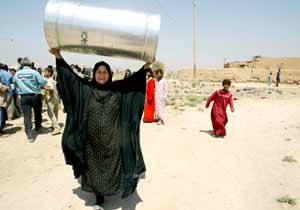
A Tawaitha woman carries a Greenpeace water barrel
People in a village near the Tuwaitha nuclear facility have been using barrels that contained radioactive material as water storage containers. This week, the Greenpeace team in Iraq asked the locals if they'd like to swap their contaminated barrels for new ones. It was an offer they happily accepted.
The Tuwaitha nuclear facility, located near Baghdad, was looted even after the US army "secured" the site. Along with various other items that could be sold as scrap metal, 500 barrels contaminated with uranium "yellowcake" were taken.
Residents living near Tuwaitha reportedly took the barrels and other containers because they needed them to store food, water, milk and yoghurt. They were unaware that the barrels had contained radioactive and toxic materials and that they were exposing themselves to severe risk.
The US army offered only US$3 in exchange for each barrel that was returned, even though it is widely known amongst the local population that a new barrel costs US$15. Of the 500 barrels that were taken since the war, about 150 are still missing.
We hope that by offering new barrels specifically designed for water storage that we can retrieve and return the last of the contaminated barrels to the US military for safe-keeping inside the Tuwaitha site.
The radiation that uranium emits does not penetrate human skin. However, uranium is a toxic substance that can readily enter the body through the lungs or gut.
Once inside the stomach, much is excreted, but some will remain in the body for years, where its radioactive decay increases the risk of bone, blood and liver cancers.
If inhaled, the risk of lung cancer is increased. Uranium in the body is also poisonous in similar ways to other non-radioactive heavy metals, and similarly increases the risk of kidney damage.
Exposure to low level radiation (such as that emitted by yellowcake) mostly causes problems that take many years to appear, including fatal and non-fatal cancers, genetic damage and other impacts, such as damage to the immune system. Children are more susceptible to radiation effects than adults.
Local doctors are concerned that people are already showing signs of radiation sickness, such as bleeding and vomiting - possibly due to exposure to some of the highly radioactive sources it is believed were looted from Tuwaitha.
Dr Jaafar Nasser Suhayb, who runs a nearby clinic, said that over a five-day period he treated about 20 patients from the neighborhood near Tuwaitha for similar symptoms: shortness of breath; nausea; severe nosebleeds; and itchy rashes. Suhayb is worried that the residents are suffering from radiation poisoning because several of the symptoms are consistent with those of acute radiation syndrome.
Updates from Iraq
The Greenpeace team finds nuclear material found in Iraqi schools.
Read the team's weblog.

